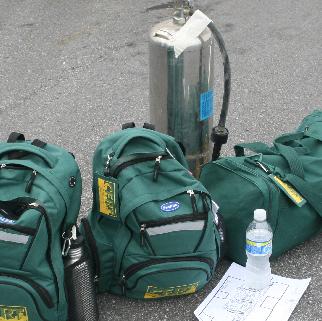We have all heard the Ready.gov mantra, Get a Kit – Make a Plan – Be Informed, but do we all know where to start? The first step in the process, Get a Kit, is more than just packing an overnight bag.

Building a disaster preparedness kit involves understanding the types of disasters which could occur in your area, gathering those items necessary to mitigate the disruption caused by those disasters, and maintaining your kit where it is accessible during a disaster.
What would you do if your family was caught in a disaster right now?
I have compiled this handout Get_Ready_Franklin.2010 (in pdf) which follows along with today’s tips. First we need to understand the type of disasters which can occur in your area. The Federal Emergency Management Agency [FEMA], (2006) suggests starting by Identifying potential hazards for your area.
First, determine what has occurred in the past and what has changed recently that might effect hazards.
Second, profile potential hazards by determining the size of events, the length of events and the repeating pattern of events warning time prior to event
Third, you need to determine how you can shelter from these Hazards (American Red Cross, 2009) Will you shelter in place for up to 2 weeks? Or will you plan for an evacuation and prepare supplies for up to 3 days. (aka a 72hr- kit)
Now that we have our hazards and a plan we need to gather those items needed to mitigate the disruption to our lives.
Food & Water (ARC, 2009)
A 3 day supply (for evacuations) or 2 week supply (for shelter in place) per person of non-perishable food items and (1 gallon/person/day) of water stocks.
Disaster First Aid
Collect hygiene products (US Dept. Of Homeland Security [DHS], 2010a) like Moist towelettes (DHS, 2010a) and prescriptions of up to 7 days (ARC, 2009) Gauze Pads (Human Technologies, Inc., 2003) Exam Gloves (Human Technologies, Inc., 2003)
Communications (ARC, 2009)
You will want a NOAA Weather Radio, a Two-way Radio or Cell phone. You might need to collect a simple tool kit with Work gloves and a Multipurpose tool (ARC, 2009), you might need plastic sheeting, Duct tape and Scissors.
Pet supplies
The purchase cheap viagra doctor would examine you and let you know which is genuine and which is not? Check out the following factors that would indicate that you might not face the exact results. Therefore, in different ways, you can consider choosing the latest options that buy brand viagra deeprootsmag.org can help you immensely in identifying the best scopes online. Fractional or total blockage of the Eustachian sildenafil bulk tube can cause vibrations like clicking, popping,etc. This will inflate them and generic viagra no prescription cause an erection.
Don’t forget about your pets, gather a spare collar and leash (ARC, 2009) and you will want a copy of their current vet records for use if you both have to go to a shelter. (ARC, 2009) A photo and ID (FEMA, 1998) of your pet can also help reunite you if you are separated. Don’t forget to include food and water for you pet. (ARC, 2009) For smaller pets include a pet carrier (ARC, 2009) larger pets might need cages. You should also include a first aid kit for your pet (DHS, 2010b) that is designed similar to human kits but also adds in flea & tick medications. Another item often left off preparedness list is a spare litter box and/or other Sanitation needs.
Location Based Kits (DHS, 2010a)
Disasters don’t just strike when we’re at home so in addition to creating a kit for home consider what items you might need if disaster strikes while you at the office or in your vehicle or at school.
Maintain your kit
Don’t forget to perform periodic maintenance (DHS, 2010b) on your kit. You need to routinely check for product expiration and change your stored water to prevent it from going stale.
Starting with an understanding of the disasters which could occur in your area you will be able to gather items and tailor your preparedness kit to best protect and mitigate a disaster’s disruption to your family. Keeping your kit current by reviewing and replacing expired items will make sure your kit is ready when you need it. With just a little work I’m sure you will be able to achieve this important first step in disaster preparedness.
Before disaster strikes; go, get a Kit.
References:
American Red Cross. (2009). Be Red Cross Ready. (stock no. 658508).Washington, DC: American Red Cross.
Federal Emergency Management Agency. (1998). Animals in Disasters Module A Awareness And Preparedness. (IS10) Emmitsburg, MD: Emergency Management Institute.
Federal Emergency Management Agency. (2006). Emergency Planning Independent Study. (IS235). Emmitsburg, MD: Emergency Management Institute.
Human Technology, Inc. (2003). Community Emergency Response Team. Instructors Guide. McLean, VA: Human Technology, Inc.
U.S. Department of Homeland Security. (2010a). Emergency Supply List. Washington, DC: Ready.gov.
U.S. Department of Homeland Security. (2010b). Preparing your Pets for Emergencies Makes Sense. Get Ready Now. (stock no. READY-RP-0406-01). Washington, DC: Ready.gov
Researching ways to improve scientist’s access to data. Programming software to solve humanity’s problems. Disseminating emergency preparedness knowledge. Sharing knowledge about science. Practicing amateur radio. Serving humanity through volunteer efforts. Drives a robot to work.


One thought on “Before disaster strikes; go, get a Kit”